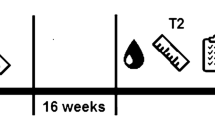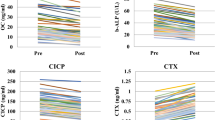Abstract
Objective: The aim of the study was to assess the effect of a 3-month pre-season preparatory period and short-term moderate aerobic exercise and intensive fitness and speed exercise on adipokine and ghrelin levels in young female handball and basketball players. Materials and methods: Fifty healthy young female professional basketball and handball players were enrolled into the study before the opening of the season (after a 2-month holiday with no training or dietary restrictions). Serum estradiol and plasma leptin, adiponectin, visfatin, and ghrelin levels were determined at the beginning and the end of a 3-month period of moderate aerobic training. Plasma adipokines and ghrelin levels were additionally assessed after 2 h of moderate aerobic exercise or after intensive fitness and speed exercise training. Results: Long-term moderate aerobic exercise was followed by a significant decrease in plasma ghrelin and leptin levels (921 ±300 vs 575±572 pg/ml. p<0.001 and 16.4±15.6 vs 11.8±16.3 ng/ml, p<0.01, respectively); plasma adiponectin and visfatin remained unchanged. No changes were observed in plasma ghrelin and leptin levels after short-term moderate aerobic exercise or after intensive fitness and speed exercise. Plasma visfatin concentration increased significantly after short-term moderate aerobic exercise (22.1 ±8.7 vs 27.6±9.0 ng/ml, p<0.001), whilst adiponectin increased after intensive fitness and speed exercise (16.7±7.8 vs 21.0±9.8 µg/ml, p<0.001). Conclusions: Regular moderate aerobic training in preparation for the match season is followed by a decline in circulating leptin and ghrelin levels even in athletes without body weight changes. Short-term intensive fitness and moderate aerobic exercise seem to modulate the production of different adipokines.
Similar content being viewed by others
References
Olszanecka-Glinianowicz M, Zahorska-Markiewicz B. Obesity as inflammatory disease. Postepy Hig Med Dosw (Online) 2008, 27: 249–57.
Chudek J, Adamczak M, Nieszporek T, Wiecek A. The adipose tissue as an endocrine organ—a nephrologist’s perspective. Contrib Nephrol 2006, 151: 79–90.
Rodríguez-Rodríguez E, Perea JM, López-Sobaler AM, Ortega RM. Obesity, insulin resistance and increase in adipokines levels: importance of the diet and physical activity. Nutr Hosp 2009, 24: 415–21.
Zahorska-Markiewicz B, Mizia-Stec K, Olszanecka-Glinianowicz M, Janowska J. Effect of weight reduction on serum ghrelin and TNFalpha concentrations in obese women. Eur J Intern Med 2004, 15: 172–5.
Feicht CB, Johnson TS, Martin BJ, Sparkes KE, Wagner WW Jr. Secondary amenorrhoea in athletes. Lancet 1978, 2: 1145–6.
Dale E, Gerlach DH, Wilhite AL. Menstrual dysfunction in distance runners. Obstet Gynecol 1979, 54: 47–53.
Glass AR, Deuster PA, Kyle SB, Yahiro JA, Vigersky RA, Schoomaker EB. Amenorrhea in Olympic marathon runners. Fertil Steril 1987, 48: 740–5.
De Souza MJ, Miller BE, Loucks AB, et al. High frequency of luteal phase deficiency and anovulation in recreational women runners: blunted elevation in follicle-stimulating hormone observed during luteal-follicular transition. J Clin Endocrinol Metab 1998, 83: 4220–32.
De Souza MJ, Williams NI. Physiological aspects and clinical squeal of energy deficiency and hypoestrogenism in exercising women. Hum Reprod Update 2004, 10: 433–48.
Hoch AZ, Stavrakos JE, Schimke JE. Prevalence of female athlete triad characteristics in a club triathlon team. Arch Phys Med Rehabil 2007, 88: 681–2.
McNeely MJ, Soules MR. The diagnosis of luteal phase deficiency: a critical review. Fertil Steril 1988, 50: 1–15.
Nattiv A, Loucks AB, Manore MM, Sanborn CF, Sundgot-Borgen J, Warren MP; American College of Sports Medicine. American College of Sports Medicine position stand. The female athlete triad. Med Sci Sports Exerc 2007, 39: 1867–82.
O’Donnell E, Harvey PJ, Goodman JM, De Souza MJ. Long-term estrogen deficiency lowers regional blood flow, resting systolic blood pressure, and heart rate in exercising premenopausal women. Am J Physiol Endocrinol Metab 2007, 292: E1401–9.
O’Donnell E, Harvey PJ, De Souza MJ. Relationships between vascular resistance and energy deficiency, nutritional status and oxidative stress in oestrogen deficient physically active women. Clin Endocrinol (Oxf) 2009, 70: 294–302.
Gordon CM. Clinical practice. Functional hypothalamic amenorrhea. N Engl J Med 2010, 363: 365–71.
Benatti FB, Polacow VO, Ribeiro SML, et al. Swimming training down-regulates plasma leptin levels, but not adipose tissue ob m RNA expression. Braz J Med Biol Res 2008, 41: 866–71.
Haluzík M, Boudová L, Nedvídková J, et al. Lower serum leptin concentrations in rugby players in comparison with healthy non-sporting subjects—relationships to anthropometric and biochemical parameters. Eur J Appl Physiol Occup Physiol 1988, 79: 58–61.
Miyazaki S, Izawa T, Ogasawara JE, et al. Effect of exercise training on adipocyte-size-dependent expression of leptin and adiponectin. Life Sci 2010, 86: 691–8.
Jürimäe J, Kums T, Jürimäe T. Plasma adiponectin concentration is associated with the average accelerometer daily steps counts in healthy elderly females. Eur J Appl Physiol 2010, 109: 823–8.
Jürimäe J, Purge P, Jürimäe T. Adiponectin and stress hormone responses to maximal sculling after volume-extended training season in elite rowers. Metabolism 2006, 55: 13–9.
O’Donnell E, De Souza MJ. Increased serum adiponectin concentrations in amenorrheic physically active women are associated with impaired bone health but not with estrogen exposure. Bone 2011, 48: 760–7.
Jürimäe J, Cicchella A, Jürimäe T, et al. Regular physical activity influences plasma ghrelin concentration in adolescent girls. Med Sci Sports Exerc 2007, 39: 1736–41.
De Souza MJ, Leidy HJ, O’Donnell E, Lasley B, Williams NI. Fasting ghrelin levels in physically active women: relationship with menstrual disturbances and metabolic hormones. J Clin Endocrinol Metab 2004, 89: 3536–42.
Holst B, Schwartz TW. Constitutive ghrelin receptor activity as a signaling set-point in appetite regulation. Trends Pharmacol Sci 2004, 25: 113–7.
Jürimäe J, Rämson R, Mäestu J, et al. Plasma visfatin and ghrelin response to prolonged sculling in competitive male rowers. Med Sci Sports Exerc 2009, 41: 137–43.
Gruodytė R, Jürimäe J, Cicchella A, Stefanelli C, Passariello C, Jürimäe T. Adipocytokines and bone mineral density in adolescent female athletes. Acta Pediatr 2010, 99: 1879–984.
Franks PW, Farooqi IS, Luan J, et al. Does physical activity energy expenditure explain the between-individual variation in plasma leptin concentrations after adjusting for differences in body composition? J Clin Endocrinol Metab 2003, 88: 3258–63.
Leidy HJ, Gardner JK, Frye BR, et al. Circulating ghrelin is sensitive to changes in body weight during a diet and exercise program in normal-weight young women. J Clin Endocrinol Metab 2004, 89: 2659–64.
Haus JM, Solomon TP, Marchetti CM, et al. Decreased visfatin after exercise training correlates with improved glucose tolerance. Med Sci Sports Exerc 2009, 41: 1255–60.
Holm C. Molecular mechanisms regulating hormone-sensitive lipase and lipolysis. Biochem Soc Trans 2003, 31: 1120–4.
Grisouard J, Bouillet E, Timper K, et al. Both inflammatory and classical lipolytic pathways are involved in lipopolysaccharides-induced lipolysis in human adipocytes. Innate Immun 2012, 18: 25–34.
Fasshauer M, Klein J, Neumann S, Eszlinger M, Paschke R. Adiponectin gene expression is inhibited by beta-adrenergic stimulation via protein kinase A in 3T3-L1 adipocytes. FEBS Lett 2001, 507: 142–6.
Ferguson MA, White LJ, McCoy S, Kim HW, Petty T, Wilsey J. Plasma adiponectin response to acute exercise in healthy subjects. Eur J Appl Physiol 2004, 91: 324–9.
Punyadeera C, Zorenc AH, Koopman R, et al. The effects of exercise and adipose tissue lipolysis on plasma adiponectin concentration and adiponectin receptor expression in human skeletal muscle. Eur J Endocrinol 2005, 152: 427–36.
Jürimäe J, Purge P, Jürimäe T. Adiponectin is altered after maximal exercise in highly trained male rowers. Eur J Appl Physiol 2005, 93: 502–5.
Ghanbari-Niaki A, Saghebjoo M, Soltani R, Kirwan JP. Plasma visfatin is increased after high-intensity exercise. Ann Nutr Metab 2010, 57: 3–8.
Schmidt A, Maier C, Schaller G, et al. Acute exercise has no effect on ghrelin plasma concentrations. Horm Metab Res 2004, 36: 174–7.
Zoladz JA, Konturek SJ, Duda K, et al. Effect of moderate incremental exercise, performed in fed and fasted state on cardio-respiratory variables and leptin and ghrelin concentrations in young healthy men. J Physiol Pharmacol 2005, 56: 63–85.
Author information
Authors and Affiliations
Corresponding author
Rights and permissions
About this article
Cite this article
Plinta, R., Olszanecka-Glinianowicz, M., Drosdzol-Cop, A. et al. The effect of three-month pre-season preparatory period and short-term exercise on plasma leptin, adiponectin, visfatin, and ghrelin levels in young female handball and basketball players. J Endocrinol Invest 35, 595–601 (2012). https://doi.org/10.3275/8014
Accepted:
Published:
Issue Date:
DOI: https://doi.org/10.3275/8014




